Home
> Car Design History - a brief overview
Throughout the decades of car design there have been many events and
technological advances which have helped bring about major design
trend changes. New technologies have made it possible for more complicated
compound curves and forms of a cars body to be built at a much speedier
rate, with more specific tolerances meaning a curvaceous body need
not require 100s of man hours with a skilled craftsman. Advances in
non-automotive technology and lifestyle have also had there impact
on car design. During the 1950s the jet age had arrived spawning a
whole host of memorable designs.
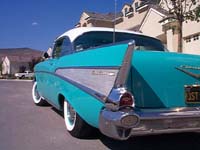 |
|
1957 Chevrolet Bel Air
|
The jet set lifestyle had captured the hearts of the American public
and designers of the time leaped on the chance to exploit this fascination.
Normally rather mundane family cars began to sprout wings, turbines,
and after-burner tail lights. At first they were styling exercises,
the 1955 Ford Thunderbird experimented with a wrap around wind shield,
it also featured exhausts which exited through the rear valence and
small turbines up front in the grill. The 1957 Chevrolet Bel Air had
unusual bomb sight ornaments laid into the bonnet although unsightly
they were small and unobtrusive and did not ruin the appeal of the
car (see
the 2002 Chevrolet BelAir concept).
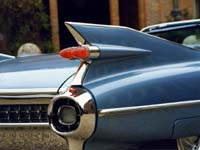 |
|
1959 Cadillac
|
The Ford Fairlane 500 Skyliner of 1959 showed by just name the extent
to which designers looked to the skies. However this trend ended abruptly
with the 1959 Cadillac. With fins which were a full 107cm, four after-burner
tail lights, wrap around wind screen, and two fake jet engine reverse
lights, this was taking it too far after the `59 jet like appendages
began to disappear.
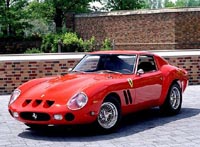 |
|
Ferrari
250 GTO
|
In Europe vehicles were undergoing a less radical change, the Jet
age did not manage to whip the European public into quite such a frenzy.
Elegant designs such as the AC ACE-Bristol which was then converted
into the much better known AC
Cobra appeared. Other well known cars such as the Aston Martin
DB4, (James Bonds favourite mode of transport) and Jaguar XK120 (see
Jaguar concepts here) were produced in England. Italy was responsible
for bringing the Ferrari 250 GT SWB on the scene, and Germany built
the Mercedes 300 Gullwing, Porsche 356 B and BMW
507. This is just a small selection of vehicles in Europe at the
time, however they show this decades contribution to car design aptly,
all the cars mentioned have things in common, they are all grandfathers
of well known cars today, they all show gorgeous rounded, clean lines
popular throughout vehicles of this era, this trend was to continue
and become more refined into the next decade.
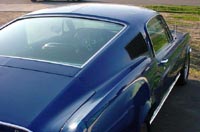 |
|
Ford Mustang
|
During the 1960s a new design competition began in America this time
for power, speed and sheer engine size, they were dubbed the `pony`
cars. Ford Mustang (see
the Shelby Mustang GT500 concept car), Chevrolet Camaro and Dodge
Charger R/T were some of the more famous names, vents appeared all
over these cars especially on the more powerful
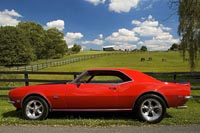 |
|
Chevrolet Camaro
|
versions, often these vents served no purpose whatsoever and were
merely for looks. Some however, were functional and force fed air
to the giant V8s lurking under the bonnet of these cars, the Charger
for example had a capacity of 7.2 litres. Raw power like this forced
styling changes to suit the cars power, muscular shapes, twin exhausts
and go-faster stripes were all the rage. Specialist tuners such as
Shelby, Yenko and Mopar appeared further improving vehicle performance
and styling. In Europe during these times timeless classics such as
the Jaguar E-type, Porsche 911, Lamborghini miura, AC Cobra (see
the new AC Cobra concept car), Aston Martin DB5, and Ferrari 275
cars synonymous with speed and beauty appeared, alongside countless
other design greats still revered today. Sports car manufacturers
also competed on the track for sales, Le Mans became a showcase for
top marques. During this time Fords gorgeous and aerodynamic
GT40 beat the competition four years in a row removing Ferraris
strangle hold.
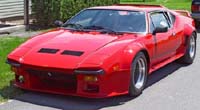 |
|
DeTomaso Pantera
|
The 1970s was a decade belonging to the wedge, high profile cars like
the BMW M1,
De
Tomaso Pantera, Lamborghini
Countach, and Lotus
Esprit wore it proudly amongst many others. Concept cars of the
day such as Bertone's
Stratos HF prototype of 1970, and Ital designs Manta designed
by Giorgietto Giugiaro, who interestingly also designed the Lotus
Esprit and BMW
M1 the seventies also heralded in very angular boxy lines which
would be a styling trait carried over into the 1980s.
Opulence, over indulgence and over priced was the trend of the 1980s,
during a decade of materialism
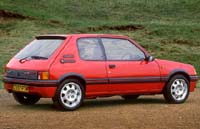 |
|
Peugeot 205 GTi
|
style was almost forgotten. Cars like the Audi Quattro looked purposeful,
aggressive and powerful but hardly beautiful, similarly the Ferrari
Testarossa was a break from the traditional flowing Ferrari lines,
with super wide slatted doors and lights and angular lines it was
different from the classic understated Ferrari. One of the most memorable
areas of car design in the eighties is that of the hot hatch. Cars
such as the Peugeot 205 GTi and Volkswagen Golf GTi (production started
on the Golf in 1975) found a place in the market easily and cemented
the hot hatch as a popular product, still expanding to this day. In
America at this time styling had taken a turn for the worse, even
the Corvette, Americas pride and joy looked worse than it ever had
before or since. Plain shapes and black plastic every where seemed
like a good idea at the time but look dated and highly un-fashionable
in retrospect.
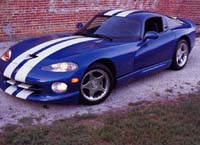 |
|
Dodge
Viper GTS
|
The early part of the 1990s saw many eighties styling traits carried
over, however once this was forgotten much more interesting shapes
appeared.
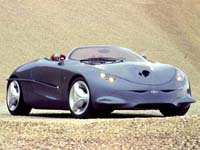 |
|
Ghia
Focus concept
|
Many were very organic the Dodge
Viper had extremely rounded lines and with its muscular haunches
and powerful looks it was less like a machine and looked more like
an animal. The Italian design house Ghia took the organic form to
an extreme with the Focus of 1992 it looked more like it had been
born than made. Curious shapes covered the car from its bubble like
tail lights and front facia which looked like some sort of pre-historic
animal, to the interior which had extremely ergonomic looking seats
and dash board. Ford's
GT90 concept of 1995 was almost the opposite of the Viper and
Ghia Focus it incorporated Fords new design policy which was that
of "edge design"it was the use of hard flat surfaces which
intersected each other. More recent products of this school of thought
would be cars like the Ford Focus and Ka.
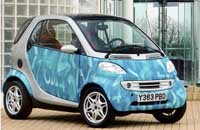 |
|
SMART Car
|
During the last few years car designers have looked to product design
for ideas, and that thinking is visible on many modern cars the Smart
car is a good example of this it looks more like a gadget than a vehicle.
Designers have also looked to the past and many updates done on existing
vehicles are actually revivals of previous design solutions remade
for the 21st century. One of the more complicated thing about car
design is bringing getting the aesthetics and ergonomics in balance,
what might look good to the eye, might be unfeasible to drive because
the driver cannot see where he is going or the seat is uncomfortable.
New technology has helped overcome some of these boundaries, and in
the future new science will further advance what is possible. Car
design is like fashion, always changing, it can never be predicted,
and often looks to the past for answers to the future.
Further Information on:
sports
cars and supercars
rare
and classic sports cars
more concept
cars
Read about the future of the automobile
|

